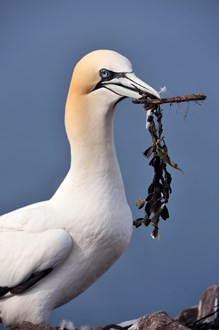18 March, 2015
Gannet numbers increase in northwest Scotland
A study of gannets off the northwest coast of Scotland has found the birds’ numbers have increased rapidly over the last decade.
This news comes hot on the heels of news in February announcing that the Bass Rock in East Lothian took over from St Kilda as the world’s largest gannet colony. The latest results confirm that Scotland – and particularly northwest Scotland - is an extremely important region for gannets, one of our most spectacular seabirds.
The SNH-commissioned survey found that gannets nesting at Sule Skerry increased at a rate of more than 47% per year. On the Flannan Islands, the growth was 7.5% per year. Numbers changed very little on St Kilda (now the world’s second-largest gannet colony) and Sule Stack.
Gannets are Scotland’s largest seabird, weighing between 2.5 to 3.5kg, with nearly a six-foot wingspan. They migrate to the west coast of Africa, and sometimes further, in the winter. They only lay one egg and pairs typically mate for several seasons, if not for life.
The good health of gannets across Scotland may be explained by their foraging behaviour. They can fly for great distances in search of food, and are able to take a wide range of prey species – features which may make them more resistant to changes in the marine environment compared with other birds. They also usually nest at sites which have few predators, have produced lots of chicks over the past decade, and have high survival rates.
Both Sule Skerry and the Flannan Islands have plenty of unused but suitable nesting habitat, and this may explain why the number of gannets in these particular colonies has increased. This contrasts to the stable numbers on Sule Stack, where gannets already occupy all the suitable breeding areas. This may lead to gannets establishing new colonies, as has already occurred at Sule Skerry, and may also be happening at Barra Head.
Eileen Stuart, SNH’s head of policy and advice, said:
“Scotland has internationally important populations of seabirds, and gannets in particular, so it’s vital that we monitor how they’re faring. The survey is especially good news as gannets are, like many seabirds, of conservation concern.”
Gannets are commonly seen around the Scottish coast throughout the spring, summer and autumn. Breeding colonies such as Bass Rock in East Lothian and Troup Head in Aberdeenshire are great places to watch them.
The latest seabird census needs volunteers to count seabirds around the coastline; to volunteer, contact the Seabird Group at www.seabirdgroup.org.uk.
To download a full copy of the report, see www.snh.gov.uk/publications-data-and-research/publications/search-the-catalogue/publication-detail/?id=2228
The gannet population estimates for the various colonies in 2013 are: St Kilda (60,290 Apparently Occupied Sites (AOS); Sula Sgeir (11,230 AOS); Flannan Islands (5,280 AOS); Sule Stack (4,550 AOS); and Sule Skerry (1,870 AOS).
Bass Rock was recently surveyed with 75,000 AOS.
ENDS
Media queries
Contact SNH media officer, Vicki Mowat, on 0131 316 2659 or vicki.mowat@snh.gov.uk (Tues-Fri) or the SNH main press office on 01463 725 022 (Mon).
Contact information
- Name
- SNH Media
- snhmedia@snh.gov.uk
NatureScot is Scotland's nature agency. We work to enhance our natural environment in Scotland and inspire everyone to care more about it. Our priority is a nature-rich future for Scotland and an effective response to the climate emergency. For more information, visit our website at www.nature.scot or follow us on X at https://x.com/NatureScot
’S e NatureScot buidheann nàdair na h-Alba. Bidh sinn a’ neartachadh àrainneachd na h-Alba agus a’ brosnachadh dhaoine gu barrachd suim a chur ann an nàdar. Tha e mar phrìomhachas againn gum bi nàdar na h-Alba beairteach agus gun dèilig sinn gu h-èifeachdach le èiginn na gnàth-shìde. Tha an tuilleadh fiosrachaidh aig www.nature.scot no air X aig https://x.com/NatureScot

